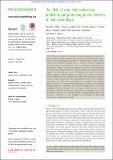Files in this item
The DNA of coral reef biodiversity : predicting and protecting genetic diversity of reef assemblages
Item metadata
| dc.contributor.author | Selkoe, Kim | |
| dc.contributor.author | Gaggiotti, Oscar Eduardo | |
| dc.contributor.author | Treml, Eric | |
| dc.contributor.author | Wren, Johanna | |
| dc.contributor.author | Donovan, Marie | |
| dc.contributor.author | Consortium, Hawaii Reef Connectivity | |
| dc.contributor.author | Toonen, Robert | |
| dc.date.accessioned | 2016-04-27T14:30:08Z | |
| dc.date.available | 2016-04-27T14:30:08Z | |
| dc.date.issued | 2016-04 | |
| dc.identifier | 241854923 | |
| dc.identifier | f8f112c9-d5d6-4aee-a023-d9a26be084bf | |
| dc.identifier | 84964776876 | |
| dc.identifier | 000376158600016 | |
| dc.identifier.citation | Selkoe , K , Gaggiotti , O E , Treml , E , Wren , J , Donovan , M , Consortium, Hawaii Reef Connectivity & Toonen , R 2016 , ' The DNA of coral reef biodiversity : predicting and protecting genetic diversity of reef assemblages ' , Proceedings of the Royal Society B: Biological Sciences , vol. 283 , no. 1829 , 20160354 . https://doi.org/10.1098/rspb.2016.0354 | en |
| dc.identifier.issn | 0962-8452 | |
| dc.identifier.other | ORCID: /0000-0003-1827-1493/work/61370096 | |
| dc.identifier.uri | https://hdl.handle.net/10023/8683 | |
| dc.description | O.E.G. was supported by the Marine Alliance for Science and Technology for Scotland (MASTS). | en |
| dc.description.abstract | Conservation of ecological communities requires deepening our understanding of genetic diversity patterns and drivers at community-wide scales. Here we use seascape genetic analysis of a diversity metric, allelic richness, for 47 reef species sampled across 13 Hawaiian Islands to empirically demonstrate that large reefs high in coral cover harbor the greatest genetic diversity on average. We found that a species’ life history (e.g., depth range and herbivory) mediates response of genetic diversity to seascape drivers in logical ways. Further, a metric of combined multi-species allelic richness showed strong coupling to species richness and habitat area, quality and stability that few species showed individually. We hypothesize that macro ecological forces and species interactions, by mediating species turnover and occupancy and thus a site’s mean effective population size, influence the aggregate genetic diversity a site, potentially allowing it to behave as an apparent emergent trait that is shaped by the dominant seascape drivers. The results highlight inherent feedbacks between ecology and genetics, raise concern that genetic resilience of entire reef communities is compromised by factors that reduce coral cover or available habitat, including thermal stress, and provide a foundation for new strategies for monitoring and preserving biodiversity of entire reef ecosystems. | |
| dc.format.extent | 10 | |
| dc.format.extent | 534537 | |
| dc.language.iso | eng | |
| dc.relation.ispartof | Proceedings of the Royal Society B: Biological Sciences | en |
| dc.subject | Population genetics | en |
| dc.subject | Seascape genetics | en |
| dc.subject | Landscape genetics | en |
| dc.subject | Resilience | en |
| dc.subject | Coral reefs | en |
| dc.subject | Ecosystem-based management | en |
| dc.subject | Allelic richness | en |
| dc.subject | GC Oceanography | en |
| dc.subject | QH301 Biology | en |
| dc.subject.lcc | GC | en |
| dc.subject.lcc | QH301 | en |
| dc.title | The DNA of coral reef biodiversity : predicting and protecting genetic diversity of reef assemblages | en |
| dc.type | Journal article | en |
| dc.contributor.institution | University of St Andrews. School of Biology | en |
| dc.contributor.institution | University of St Andrews. Marine Alliance for Science & Technology Scotland | en |
| dc.contributor.institution | University of St Andrews. Scottish Oceans Institute | en |
| dc.identifier.doi | 10.1098/rspb.2016.0354 | |
| dc.description.status | Peer reviewed | en |
This item appears in the following Collection(s)
Items in the St Andrews Research Repository are protected by copyright, with all rights reserved, unless otherwise indicated.

